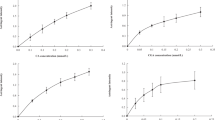Abstract
Flavor characteristics and chemical compositions of Tieguanyin oolong tea processed using different semi-fermentation times were investigated. Six flavor attributes of the teas, namely, astringency, bitterness, umami, sweet aftertaste, floral flavor, and green fruity flavor, were analysed. With extended semi-fermentation time, the taste intensity of sweet aftertaste increased, and the aroma intensity of floral and green fruity flavors increased, while the intensities of astringency, bitterness, and umami showed no clear trend. With increasing semi-fermentation time, the concentrations of gallated catechins, myricetin-rhamnose, quercetin-rutinoside, myricetin, and theanine greatly decreased, while those of total theaflavins, vitexin-rhamnose, kaempferol-galactose, kaempferol-rutinoside, vitexin, quercetin, and kaempferol increased significantly. The intensity of bitter taste was positively correlated with the concentrations of total catechins and gallated catechins. The intensity of astringent taste strongly correlated with the flavonoid concentrations, and that of sweet aftertaste positively correlated with the concentrations of (−)-epigallocatechin and (−)-epicatechin. However, dose-over-threshold analysis revealed that catechins, theaflavin, flavonol glycosides, and caffeine are the main taste-active compounds contributing to the taste of Tieguanyin oolong tea. The concentrations of total volatiles and most of the esters increased markedly with the semi-fermentation time, while the concentrations of low aldehydes showed a significant decrease. The flavor index was consistent with the intensity of floral aroma, increasing from 0.59 (12 h) to 0.84 (24 h) and then decreasing to 0.63 (32 h). Results of this work suggest that the flavor change is mainly due to the variation of taste-active and aroma-active compounds in oolong tea.
Similar content being viewed by others
References
Alasalvar C, Topal B, Serpen A, Bahar B, Pelvan E, Gökmen V (2012) Flavor characteristics of seven grades of black tea produced in Turkey. J Agric Food Chem 60(25):6323–6332
Chen Y, Jiang Y, Duan J, Shi J, Xue S, Kakuda Y (2010a) Variation in catechin contents in relation to quality of ‘Huang Zhi Xiang’ Oolong tea (Camellia sinensis) at various growing altitudes and seasons. Food Chem 119(2):648–652
Chen YL, Duan J, Jiang YM, Shi J, Peng L, Xue S, Kakuda Y (2010b) Production, quality, and biological effects of oolong tea (Camellia sinensis). Food Rev Int 27(1):1–15
Chen YJ, Kuo PC, Yang ML, Li FY, Tzen JT (2013) Effects of baking and aging on the changes of phenolic and volatile compounds in the preparation of old Tieguanyin oolong teas. Food Res Int 53(2):732–743
Dev Choudhury MN, Bajaj KL (1979) Incorporation of 14 C-compounds into amino acids and polyphenols of excised tea shoots. Plant Biochem J 6:16–23
Dou J, Lee VS, Tzen JT, Lee MR (2007) Identification and comparison of phenolic compounds in the preparation of oolong tea manufactured by semifermentation and drying processes. J Agric Food Chem 55(18):7462–7468
Gong SY, Lu CY, Liu X, Zhao YX, Shen H, Gou YL, Wu JH, Zhao L, Gu ZL (2009) Methodology of sensory evaluation of tea (GB/T 23776-2009). Standards Press of China, Beijing
Haslam E (2003) Thoughts on thearubigins. Phytochem 64(1):61–73
Hayashi N, Chen R, Ikezaki H, Ujihara T (2008) Evaluation of the umami taste intensity of green tea by a taste sensor. J Agric Food Chem 56(16):7384–7387
Kawakami M, Ganguly SN, Banerjee J, Kobayashi A (1995) Aroma composition of oolong tea and black tea by brewed extraction method and characterizing compounds of Darjeeling tea aroma. J Agric Food Chem 43(1):200–207
Liang Y, Lu J, Zhang L, Wu S, Wu Y (2003) Estimation of black tea quality by analysis of chemical composition and colour difference of tea infusions. Food Chem 80(2):283–290
Lin JK, Lin CL, Liang YC, Lin-Shiau SY, Juan IM (1998) Survey of catechins, gallic acid, and methylxanthines in green, oolong, pu-erh, and black teas. J Agric Food Chem 46(9):3635–3642
Lin J, Zhang P, Pan Z, Xu H, Luo Y, Wang X (2013) Discrimination of oolong tea (Camellia sinensis) varieties based on feature extraction and selection from aromatic profiles analysed by HS-SPME/GC–MS. Food Chem 141(1):259–265
Narukawa M, Kimata H, Noga C, Watanabe T (2010) Taste characterisation of green tea catechins. Int J Food Sci Technol 45(8):1579–1585
Nishimura T, Kato H (1988) Taste of free amino acids and peptides. Food Rev Int 4(2):175–194
Obanda M, Okinda Owuor P, Mang’oka R (2001) Changes in the chemical and sensory quality parameters of black tea due to variations of fermentation time and temperature. Food Chem 75(4):395–404
Owuor PO, Odhiambo HO, Robinson JM, Taylor SJ (1990) Variations in the leaf standard, chemical composition and quality of black tea (Camellia sinensis) due to plucking intervals. J Sci Food Agric 52(1):63–69
Scharbert S, Hofmann T (2005) Molecular definition of black tea taste by means of quantitative studies, taste reconstitution, and omission experiments. J Agric Food Chem 53(13):5377–5384
Scharbert S, Holzmann N, Hofmann T (2004) Identification of the astringent taste compounds in black tea infusions by combining instrumental analysis and human bioresponse. J Agric Food Chem 52(11):3498–3508
Shimoda M, Shigematsu H, Shiratsuchi H, Osajima Y (1995) Comparison of the odor concentrates by SDE and adsorptive column method from green tea infusion. J Agric Food Chem 43(6):1616–1620
Suzuki H, Izuka S, Miyakawa N, Kumagai H (2002) Enzymatic production of theanine, an “umami” component of tea, from glutamine and ethylamine with bacterial γ-glutamyltranspeptidase. Enzyme Microb Technol 31(6):884–889
Vuong QV, Golding JB, Nguyen M, Roach PD (2010) Extraction and isolation of catechins from tea. J Separ Sci 33(21):3415–3428
Wang D, Kubota K, Kobayashi A, Juan IM (2001) Analysis of glycosidically bound aroma precursors in tea leaves. 3. Change in the glycoside content of tea leaves during the oolong tea manufacturing process. J Agric Food Chem 49(11):5391–5396
Wang HF, Tsai YS, Lin ML, Ou ASM (2006) Comparison of bioactive components in GABA tea and green tea produced in Taiwan. Food Chem 96(4):648–653
Wang LF, Lee JY, Chung JO, Baik JH, So S, Park SK (2008) Discrimination of teas with different degrees of fermentation by SPME–GC analysis of the characteristic volatile flavour compounds. Food Chem 109(1):196–206
Wang L, Xu R, Hu B, Li W, Sun Y, Tu Y, Zeng X (2010) Analysis of free amino acids in Chinese teas and flower of tea plant by high performance liquid chromatography combined with solid-phase extraction. Food Chem 123(4):1259–1266
Wang K, Liu F, Liu Z, Huang J, Xu Z, Li Y, Yang X (2011) Comparison of catechins and volatile compounds among different types of tea using high performance liquid chromatograph and gas chromatograph mass spectrometer. Int J Food Sci Technol 46(7):1406–1412
Wu C, Xu H, Héritier J, Andlauer W (2012) Determination of catechins and flavonol glycosides in Chinese tea varieties. Food Chem 132(1):144–149
Xin W, Hong Y, Lu L, Wang F (2012) Sensory evaluation and chemical components analysis on Tieguanyin of different shaking styles in Anxi for yinyun (in Chinese). J Wuyi Univ 31(5):38–40
Zhang YN, Yin JF, Chen JX, Wang F, Du QZ, Jiang YW, Xu YQ (2016) Improving the sweet aftertaste of green tea infusion with tannase. Food Chem 192:470–476
Zhao W, Yang R, Lu R, Wang M, Qian P, Yang W (2008) Effect of PEF on microbial inactivation and physical–chemical properties of green tea extracts. LWT-Food Sci Technol 41(3):425–431
Acknowledgements
This research was supported by the National Natural Science Foundation of China (31101248, 31671861), Natural Science Foundation of Zhejiang (LR17C160001), and the Innovation Project for Chinese Academy of Agricultural Sciences (CAAS-ASTIP-2014-TRICAAS) and the Young Elite Scientist Sponsorship Program by CAST.
Author information
Authors and Affiliations
Corresponding author
Rights and permissions
About this article
Cite this article
Liu, PP., Yin, JF., Chen, GS. et al. Flavor characteristics and chemical compositions of oolong tea processed using different semi-fermentation times. J Food Sci Technol 55, 1185–1195 (2018). https://doi.org/10.1007/s13197-018-3034-0
Revised:
Accepted:
Published:
Issue Date:
DOI: https://doi.org/10.1007/s13197-018-3034-0




